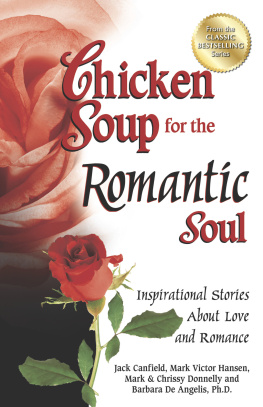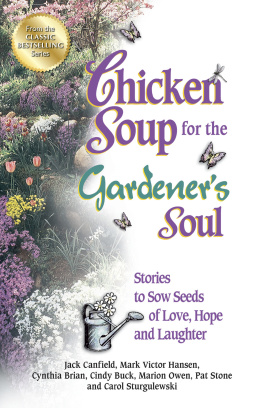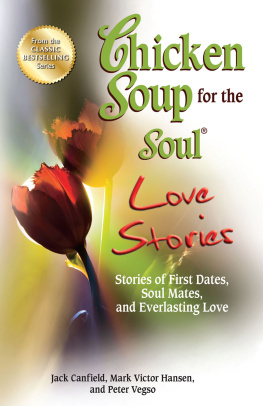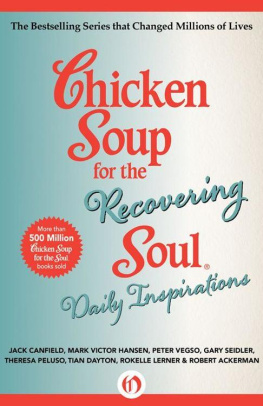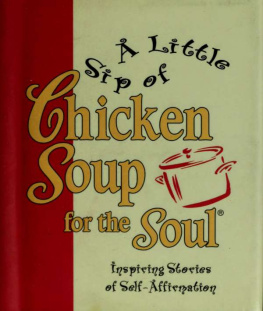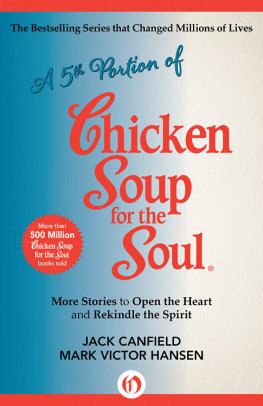
Table of Contents

We dedicate this book
to the tea drinkers of the world,
who find such splendid comfort in tea,
the worlds most popular beverage.
Acknowledgments
Compiling, editing, and publishing a book requires the energy and expertise of many people. First, a huge thank-you to our families. Jacks wife, Inga, and their children, Christopher, Travis, Riley, Oran, and Kyle, for all their love and support. Marks family, Patty, Elisabeth, and Melanie, for once again sharing and lovingly supporting us in creating yet another book.
Patricia enjoys the love and support of her family: her parents, Ed and Bev Kobbeman; her four children, Jeanne, Julia, Michael and Andrew, and their spouses; her eight grandchildren, Hailey, Hannah, Zachary, Casey, Riley, Chloe, Adeline, and Ethan; her brother and sister and their families; and her many friends scattered around the country.
The vision and commitment of our publisher, Peter Vegso, brings Chicken Soup for the Soul to the world.
Patty Aubery and Russ Kalmaski share this journey with love, laughter, and endless creativity. Patty Hansen has handled the legal and licensing aspects of each book thoroughly and competently, and Laurie Hartman has been a precious guardian of the Chicken Soup for the Soul brand. Michelle Adams, Noelle Champagne, Dette Corona, Lauren Edelstein, Jody Emme, Teresa Esparza, Jesse Ianniello, Tanya Jones, Debbie Lefever, Barbara LoMonaco, Mary McKay, Dee Dee Romanello, Gina Romanello, Veronica Romero, Brittany Shaw, Shanna Vieyra, Lisa Williams, and Robin Yerian support Jacks and Marks businesses with skill and love.
Thank you to Theresa Peluso, a fellow Chicken Soup coauthor, who assisted in putting this book together, kept us organized and on schedule, and made it easy. We appreciate Andrea Golds, effort in editing this book and the work of HCIs editorial department, directed by Michelle Matriciani, and the HCI creative team, led by Larissa Hise Henoch, whose efforts make each book special. And to the rest of the staff at HCI, who for their sheer numbers must go nameless, who get all of our books into readers hands, copy after copy, with dedication and professionalism.
Readers around the world enjoy Chicken Soup for the Soul in more than thirty-six languages because of the efforts of Claude Choquette and Luc Jutras at Montreal Contacts, The Rights Agency.
Our thanks and appreciation go out to the hundreds of writers who opened their hearts and submitted such delectable stories about their enjoyment of tea. We regret that we couldnt publish them all in this book.
And we wish to acknowledge the volunteers who graciously donated time to help us select these stories. Thank you: Katherine Bontrager, Jennifer Campbell, Deb Karpek, Katy McManus-Semphill, Julie Miller, Marsha Oldfield, Melanie Rigney, Sallie Rodman, Diane Smith, Ken Thompson, Patty Tinsdale, Maddy Underbrock, Dave Wilkins, Dona Williams, Heather Young, Phyllis Zeno, and Lora Zill.
Introduction
When I was very young, possibly in the early grade-school years, my mother and father, Ed and Lucy Kobbeman, invited me to sit with them in the evenings at the old walnut kitchen table in our home in Rock Falls, Illinois. Mother would boil water, dip a tea bag in my cup for just twenty or thirty seconds, then add it to her cup for a full brewing. Mom, Dad, and I would sit there and talk about life, school, family events. It made me feel so very grown-up to not only be included in their talks, but to be allowed to drink tea with them. I think I actually enjoyed the tea even more than the cookies that sometimes accompanied our little tea party.
Those sweet evenings were the beginning of a lifetime of delicious tea drinking for me, and to this day I have never had a cup of coffee in my life. My beverage of choice during my entire adult life has been tea, glorious tea. These days I have eighty different flavors of tea from many countries sitting in glass jars that I have hand-painted on my kitchen counter. I learned years ago that tea must be kept sealed in a tight, glass container or it loses its flavor.
I think Ive enjoyed more cups of tea than anyone I know. I drink tea alone or with friends, family, neighbors, or anyone who stops by.
On my kitchen cabinet, right next to my stove where my white teakettle resides, is a quote I cherish from British Prime Minister William Gladstone:
If youre cold, tea will warm you.
If youre heated, it will cool you.
If youre depressed, it will cheer you.
If youre excited, it will calm you.
I believe those words, mainly because Ive experienced them all. Somehow, a cup of tea in my favorite hand-crafted ocean-blue pottery mug with the large handle just makes life a better, warmer/cooler, happier, calmer, and more contented place to be than if I was slurping sodas out of a can or hoisting water bottles for every ounce of my prescribed daily liquids.
Tea is charming in its variety of flavors. Its civilized because it cant be hurried. Its universal. There isnt a country in the world where the people dont drink tea mingled with delightful, unique-to-that-country traditions.
Tea is refreshing. It gets you off to a good start in the morning, makes for a lovely midday break, and is the perfect nightcap before bed.
Universally celebrated in drama, poetry, commerce, and international relationships, tea has had an influence on lives all over the world. In England, drinking tea is a social custom. English afternoon tea combines the best cups of tea in dainty teacups with tea breads, finger sandwiches, sausage rolls, scones, and sponge and seed cakes. Soothing and civilized, the ritual of afternoon tea offers a welcome respite from the hustle and bustle of daily life as the tea drinkers enjoy pleasant conversation and determined relaxation.
In Japan, tea drinking has ceremonial overtones. China has cultivated and extolled tea for centuries. America found tea a favorite brew in colonial times and a political force during the Revolutionary War.
Sri Lanka, China, India, and Kenya are among the tropical and subtropical regions that produce tea, both the green and black variety.
The difference between black and green tea is simple. Black tea leaves are picked, allowed to wither and oxidize or ferment, and then are dried. Green teas are steamed and dried, but never fermented.
Part of the fun of being a tea drinker is the way tea drinking keeps you busy. First, you get to swish the bag around in the cup of hot water, adding lemon, sugar, milk, cream, honey, or any combination of the above. Then, when the tea is the right strength, you lift the bag out of the cup onto your teaspoon, gently wrapping the attached string under and over the top of the spoon and the wet bag so it can be squeezed with the string a couple of times. This keeps the bag from dripping all over the table when you dispose of it.
Then, when youre ready for another cup, you start all over, pouring, dangling, swishing, adding milk, cream, sweetener, or lemon... creating a masterpiece of flavor.
The beauty of tea is that it is never boring. There are hundreds, perhaps thousands, of flavors to choose from in all different combinations of black, green, or natural herb teas. For instance, a deliciously simple-tasting tea called Country Peach Spice is actually a combination of hibiscus flowers, cinnamon, roasted chicory root, rosehips, hawthorn berries, blackberry leaves, orange peel, tilia flowers, peaches, natural peach flavors, nutmeg, and other natural flavors.
Next page




